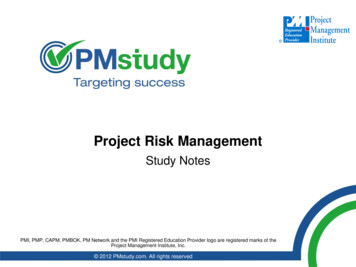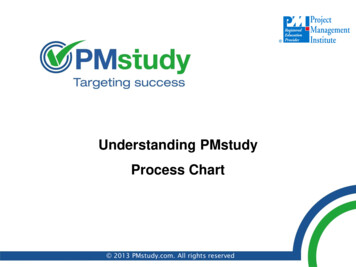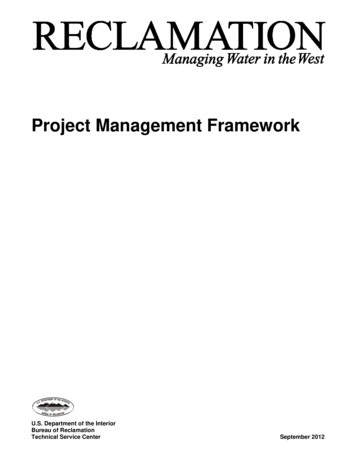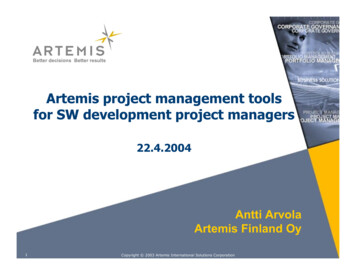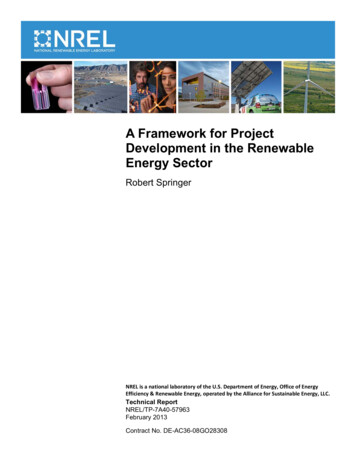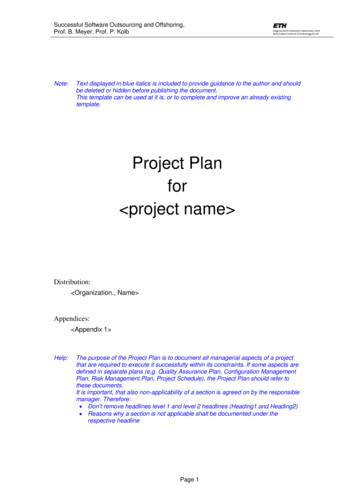
Transcription
Project Management FrameworkStudy NotesPMI, PMP, CAPM, PMBOK, PM Network and the PMI Registered Education Provider logo are registered marks of theProject Management Institute, Inc. 2013 PMstudy.com. All rights reserved
Points to Note Please read Chapter 1, Chapter 2, and Chapter 3 from Project Management Institute, A Guideto the Project Management Body of Knowledge, (PMBOK Guide) – Fifth Edition, ProjectManagement Institute, Inc., 2013 (pages 1 to 61). The study notes explains topics that are important for PMP exam preparation and you canexpect several questions from these topics. Pay close attention to all the terms used. It is very important to understand all the conceptsdiscussed in this chapter. Try to relate the concepts to real life examples. After reading the study notes, please read, understand, and answer the chapter testquestions in this knowledge area. The chapter questions improve your understanding of theconcepts discussed in the study notes. 2013 PMstudy.com. All rights reserved2
What is a Project? *Project is a temporary endeavor undertaken to create a unique product, service, or result. Features of project: Temporary: Project has a definite beginning and a definite ending. The duration may vary from one day toeven a few years – but ultimately all projects must either meet their objectives or be terminated. Pleasenote that even though the projects are temporary, the products or services created by them may far outlastthe projects themselves. Unique product, service or result: All projects create something unique which has never been createdbefore. A product or service may be unique to whatever category it belongs (e.g., a project to create abuilding has a unique design, location, resources, etc.). Please visualize those situations at your work place and check whether what you are working on is in fact aproject or some other engagement, taking into account the following guidelines that help you understand someof the characteristics of a project: Does it have features of operations that are repetitive, and required to sustain business? Does it relate to merely fixing something which is broken or making minor modifications or carrying onmaintenance activities (e.g., making changes in a document or website, resolving minor issues, etc.)?These activities will not produce a unique product and are hence not projects. Does the work require you to follow project management practices (e.g., does it require you to use expertknowledge discussed in several PMBOK Guide Knowledge Areas such as Integration Management, TimeManagement, Scope Management, Cost Management, etc.?)? Does it require a project plan to be createdand Project Manager assigned? If answers to these questions are “No”, then you are not dealing withprojects.Important: Please read PMBOK Guide Fifth Edition (pages 3 and 4) which cites examples of projects and howthey can be identified.*This definition is taken from the Glossary of the Project Management Institute, A Guide to the Project Management Body of Knowledge, (PMBOK Guide) – Fifth Edition, ProjectManagement Institute, Inc., 2013 2013 PMstudy.com. All rights reserved3
Projects and Operations(How they differ)ProjectsOperationsDurationTemporary - has definitebeginning and definite end(although duration may vary)Ongoing activityObjectiveDeliver service/product andclose the projectSustain businessCreate unique product orserviceSustain businessEnd Result 2013 PMstudy.com. All rights reserved4
Programs, PMO, and Portfolios Program: *A group of related projects, subprograms, and program activities managed in acoordinated way to obtain benefits not available from managing them individually. Program management (as opposed to project management) is important because: It provides a holistic view of several related projects which, if executed together, willachieve better results than when executed individually. It satisfies a distinct strategic objective, which requires management of several projectssimultaneously.e.g.: A space launch is usually a program. It includes several individual projects relatedto manufacturing, testing, creating the launch pad, R&D, etc. It may also includeoperational activities like co-ordination with research institutes, compliance withprocedures, remembering lessons learned from other launch programs, etc. For thespace launch to be successful, all the underlying projects and associated operationalactivities should be well coordinated and executed as part of a single program.*This definition is taken from the Glossary of the Project Management Institute, A Guide to the Project Management Body of Knowledge, (PMBOK Guide) – Fifth Edition, ProjectManagement Institute, Inc., 2013 2013 PMstudy.com. All rights reserved5
Programs, PMO, and Portfolios (continued) Project Management Office (PMO): *An organizational structure that standardizes the project-related governance processesand facilitates the sharing of resources, methodologies, tools, and techniques. An entity that selects, deploys, and manages project resources Portfolio: *Projects, programs, subportfolios, and operations managed as a group to achieve strategicobjectives. Portfolio Management is important because: It satisfies strategic business objectives. It identifies, prioritizes, authorizes, controls, and manages projects, programs, and otherrelated work.e.g.: A space launch portfolio will include several individual space launch programs. ThePortfolio Manager will be instrumental in determining which space launch programs should beselected based on risks, returns, human resources, strategic objectives, and otherconsiderations. Also, all the programs and projects will be managed as part of the portfolio andfollow the standards & guidelines laid down as part of the portfolio.Important: Please read PMBOK Guide Fifth Edition (pages 7 to 12) which discussesthese concepts in greater detail.*These definitions are taken from the Glossary of the Project Management Institute, A Guide to the Project Management Body of Knowledge, (PMBOK Guide) – Fifth Edition,Project Management Institute, Inc., 2013 2013 PMstudy.com. All rights reserved6
Project Stakeholders*An individual, group, or organization who may affect, be affected by, or perceive itself to be affected by adecision, activity, or outcome of the project. Some examples are: Project Managers: Responsible for managing the project Not required to be a technical expert Customers: *Person(s) or organization(s) that will pay for the project’s product, service, or result (e.g., for a newcomputer processor manufacturing project, the computer manufacturers are the customers). Users: Those who directly use the project’s product (e.g., when a new drug is launched, patients are the users) Functional Managers: Responsible for managing the work related to the functional areas of the business Sponsor: Provides resources and support for the project, is accountable for the project success, and serves as anescalation point for important issues. Project Team: Group of persons that carries out the project work Program Managers: Responsible for managing related projects Portfolio Managers/ Portfolio Review Board: Responsible for governing a number of projects or programs that may or may not be interdependent.*These definitions are taken from the Glossary of the Project Management Institute, A Guide to the Project Management Body of Knowledge, (PMBOK Guide) – Fifth Edition,Project Management Institute, Inc., 2013 2013 PMstudy.com. All rights reserved7
Characteristics of Project Stakeholders Stakeholders’ interests may positively or negatively impact the project. Stakeholders may exert influence over the project and its outcome. Very important for the Project Manager to identify all the stakeholders and their expectations(sometimes their expectations may be implicit and not explicitly stated). Stakeholders may have conflicting interests and objectives; so managing stakeholders mayinvolve balancing those interests. Project Manager must aim to find resolutions to issues among various stakeholders. Involving stakeholders in the project phases improves the probability of successfullycompleting the project and thus satisfying customer requirements. This may also result in buyin or shared ownership of the project by the stakeholders. In general, differences among stakeholders must be so resolved in favor of the customer. 2013 PMstudy.com. All rights reserved8
Organizational Structures—Their Influenceon ProjectsReference: Project Management Institute, A Guide to the Project Management Body of Knowledge, (PMBOK Guide) –Fifth Edition, Project Management Institute, Inc., 2013 – Table 2-1, Page 22. Also, please refer PMBOK Guide - FifthEdition - Figures 2-1 through 2-6, Pages 22 to 26. 2013 PMstudy.com. All rights reserved9
Comparison of Functional vs. ProjectizedOrganization StructuresFunctionalProjectizedProject Manager's authorityVirtually noneHigh to almost totalAbility to get resources forprojectVery difficult, because resources workin specific functional areasEasier to get resourcesReporting hierarchyResources report to FunctionalManagerResources report to Project ManagerDedication to the projectLowHighPerformance EvaluationDone by Functional ManagerDone by Project ManagerHome for the resource afterproject completedAvailable, resources go back tofunctional departmentsNo home after project is completedSpecialized skillsWell developed, because resourcesplace more emphasis on functionalskill-sets compared to projectsNot as well developed, team membersneed to pay more emphasis toprojects and not to develop functionalskill-setsEfficiency of resourceallocationEfficient allocation of resourcesLess efficient- duplication of jobfunctionsCareer pathsWell defined - along functionalspecializationDepends on type of project, no welldefined career path 2013 PMstudy.com. All rights reserved10
Some Important Terms *Project Management Office (PMO): It is an organizational structure that standardizes theproject-related governance processes and facilitates the sharing of resources, methodologies,tools, and techniques. *Program: A group of related projects, subprograms, and program activities managed in acoordinated way to obtain benefits not available from managing them individually. *Portfolio Management: The centralized management of one or more portfolios to achievestrategic objectives. *Subproject: A smaller portion of the overall project created when a project is subdivided intomore manageable components or pieces.*These definitions are taken from the Glossary of the Project Management Institute, A Guide to the Project Management Body of Knowledge, (PMBOK Guide) – Fifth Edition,Project Management Institute, Inc., 2013 2013 PMstudy.com. All rights reserved11
Product Life Cycle, Project Life Cycle,Project Management Life Cycle *Product Life Cycle: The series of phases that represent the evolution of a product, fromconcept through delivery, growth, maturity, and to retirement.The product lifecycle is used to launch a new product. A single product life cycle may havebeen generated as an outcome of several projects (multiple project life cycles). For example, aproject undertaken to bring out a new desktop computer in to the market constitutes only onephase in the product life cycle of the desktop computer. *Project Life Cycle: The series of phases that a project passes through from its initiation to itsclosure.Understanding the project life cycle constitutes the basic framework needed for managing theproject. Project Management Life Cycle: It describes the processes required to be followed tomanage the project and are grouped under various process groups (i.e., Initiating, Planning,Executing, Monitoring & Controlling, and Closing) explained in PMBOK Guide - Fifth Edition.*These definitions are taken from the Glossary of the Project Management Institute, A Guide to the Project Management Body of Knowledge, (PMBOK Guide) – Fifth Edition,Project Management Institute, Inc., 2013 2013 PMstudy.com. All rights reserved12
Project Life Cycle - Features Defines the beginning and end of the project Includes the transitional activities at the beginning and the end of the project (thus provideslinkages with ongoing operations of the performing organization) Defines work and resources involved in each phase Project life cycle may be just one phase of the product life cycle Subprojects within projects have their own distinct life cycles 2013 PMstudy.com. All rights reserved13
Project Life Cycle - CharacteristicsFactors that increase with project progress and then decrease sharply when projectnears completion: Cost of project Staffing levelsStart of projectProject Duration 2013 PMstudy.com. All rights reservedEnd of project14
Project Life Cycle – Characteristics(continued)Factors that increase with project progress: Probability of successfully completing the project Cost of changes made Cost of correcting errorsStart of projectProject Duration 2013 PMstudy.com. All rights reservedEnd of project15
Project Life Cycle – Characteristics(continued)Factors that decrease with project progress: Uncertainty/risks about the project Ability of stakeholders to influence final characteristics of project’s product Ability of stakeholders to influence final cost of project’s productStart of projectProject Duration 2013 PMstudy.com. All rights reservedEnd of project16
Process Groups The five process groups or project management process groups are: Initiating Planning Executing Monitoring and Controlling Closing Process groups are linked by the results they produce, i.e., output of one process groupbecomes input to the succeeding process group. Process groups may overlap and interact within phases. If a project is broken down into several phases (e.g., design, implementation, etc.), then
PMI, PMP, CAPM, PMBOK, PM Network and the PMI Registered Education Provider logo are registered marks of the Project Management Institute, Inc. Points to Note Please read Chapter 1, Chapter 2, and Chapter 3 from Project Management Institute, A Guide .
